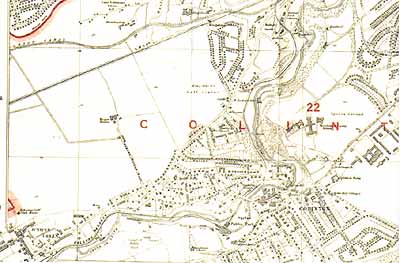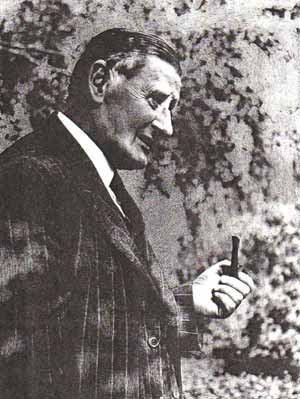Memories of Juniper Green
A View of Juniper Green from down the Wester Hailes Road...
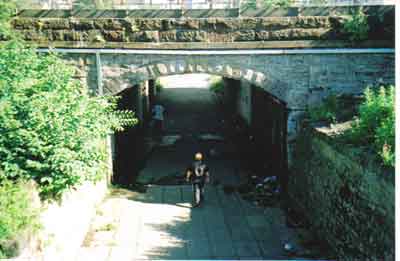
A modern image of Allan Kermack standing under the bridge where the old Wester Hailes road went under the railway
From the top of Lanark Road in the 1940s, walking north down Wester Hailes Road the track was much different to that of today. The road drifted right for about 500 yards then turned sharp left, another 500 yards or so and the road snaked back right before turning once more to go under the railway bridge and on over the canal. The road was dark at night with only 3 gas lights down that first part of the road then countryside darkness the rest of the way. However, you were rarely afraid and you just got used to it in those days. So are the initial memories of John Kermack who spent the first eleven years of his life in cottages down the Wester Hailes Road.
Leaving Gillespie Crossroads and the houses on the corner there was a smallholding on the right and adjoining it was Alec Henderson's smallholding. Then, a set of cottages one of which housed the Kermack family from the late 1930s. John Kermack's father and mother joined the Kermack grandparents in another of the cottages in 1939. John was a small baby with older sister Jane when the family moved. John's other brothers Eric and Allan and younger sister Barbara were born while the family lived in the cottages. By 1950 the family had moved to Sighthill leaving many happy memories of their childhood in Juniper Green. There were 9 cottages in all as shown in John's diagram below but the cottages had gone by the middle 1950s.
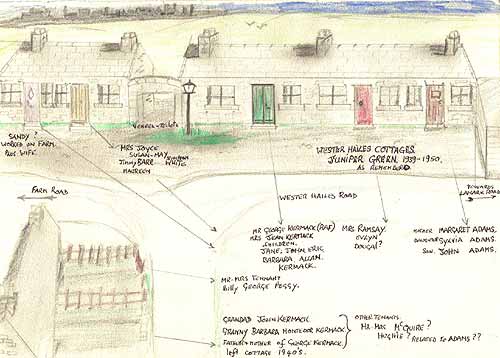
John Kermack's sketch of the cottages where he stayed in the 1940s with details of other families living there at the time
John's father had been in the RAF during the War and worked in the rubber mills at Fountainbridge. John tells of his walk up the hill from the cottages to catch the bus at the Gillespie Crossroads, the bus driver would wait when he saw the head of his older sister Jane coming up the brae. The Kermack's did not always take the bus and many was the morning they would turn right at the crossroads, walk along the Lanark Road picking up other schoolchildren as they went before turning up Foulis Crescent and on to school. One morning a steamroller made for a little time wasting and you had to have a good excuse for being late when you arrived at the school or Miss Steele would want to know why! Miss Steele was an excellent teacher and one who could have won the War on her own.
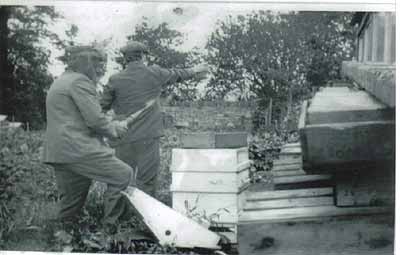
John's father and grandfather tending the beehives outside the Wester Hailes cottages
John remembers sitting in his bedroom window in the cottage and watching the firework displays over the castle possibly at the end of the War or for a New Year. During the War the families at the cottages would use the 2 Anderson shelters nearby. When the sirens went the children were sent into the shelter while grandma made some tea. One night she came in but missed her footing and the whole tray of cups, milk, tea and teapot came crashing down and gave the children a bigger fright than did Herr Hitler!
John remembers some of the characters at that time: the gentleman who broke up stones to start the foundation of a road along what is now Viewfield Road, Mr Milne John thought. It seemed to take him for ever recalled John.
Another smallholding down the Wester Hailes Road was owned by the Shanley brothers: Johnnie, Barney and Jimmy. Alec Henderson had chickens, pigs and a couple of cows whereas the Shanley's had a horse, chickens, goats and about forty pigs. They also grew lettuce, cabbage, cauliflowers, potatoes and many other vegetables. John remembers a lorry arriving with stale bread from a bakery in town and the children might get some of the better loaves to "take home for toast by the fire". The Shanley's would also ask the children for help in picking and packing up some of the vegetables for sale probably to go into town, they would reward the helpers with "Something to take home for tea". Then, there were the days that the Shanley's billy goat got out and chased the children!
The people down Wester Hailes Road looked to Juniper Green for their schooling and their doctors. John remembers Dr Sellar and Dr Ross with fondness. In fact, after they had left the village John still returned to the village for the services of the doctor. One time when the school doctor would not sanction John going off to the "tattie howking" he came up to the village and gained permission from Dr Ross in Southernwood. John recalls going down to Duns, probably for a fortnight, at the autumn half-term and picking potatoes by the bucketload. There would be as many as 100 folk or more, sleeping in dormitories overnight and the children would receive a visit from their parents in the middle weekend. The work was hard but not excessive and John enjoyed it.
The usual children's games were played: hide and seek, peevers, marbles and tig. At Halloween, the children dressed up and visited the bigger houses on the Lanark Road but only hoped for fruit, biscuits or sweeties not money. In those days they were expected to perform a song or poem.
St Margaret's Church was also an important part of village life with its choir, youth organisations and Sunday School picnics. One picnic in particular to Burntisland was memorable and John can tell you to this day where the church stands in the Fife coastal town where he received his food and drink that day.
Miss Spalding of Juniper Green school taught John to draw, a skill which he took to the senior school where his painting of a still life was entered into a nationwide exhibition by the 1953 Sunday Pictorial Children's Art Competition. The exhibition toured the country and John remembers going up with his teacher to see his painting in Dundee where he met Lady Lyle.

